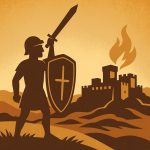| Host: | Brant Berglin |
|---|---|
| Guests: | James Ash |
| Quarter: | Allusions, Images, Symbols |
| Lesson: | 8 |
| Sabbath: | May 24th, 2025 |
Opening Question
Do you love poetry? Why or why not?
Introduction
The figurative language of poetry allows us to not only express specific ideas, but also feelings, images and pictures in ways that prose cannot. The use of symbols, of metaphor, simile, parallelism, and chiasm all contribute to create literary pictures and emotions that resonate in the heart, that move and draw us. Revelation borrows much of the imagery of the Psalms. The lesson this week explores some of these connections.
The Psalms as a Whole
It is helpful to consider the lyrics (sadly, most of the music is lost to us) of the Psalms, and compare their situation to the experiences of God’s people in Revelation and in the last days. It is common to see the Psalmist running from enemies who seek his life, and turning to God who alone can save in this time of tribulation or distress. God comes to the singer’s aid, and shows His power, and is worthy of praise for His salvation. But there are also times when the song-writer does not sense God’s powerful presence; seemingly left alone in darkness, the words flow out in frustration, yet refusing to let go of the only One who can save. Revelation likewise pictures the saints of God facing tremendous persecution, going through a “time of trouble such as never was” and coming through the other side following the Lamb wherever He goes. These similarities suggest that the Psalms are not just songs for Israel in the past, nor are they for our present times of difficulty and devotion, but for a last-day experience when God’s final Israel will be, like Abel, persecuted by their own brothers. The Psalms are to be learned, memorized, and hung on to like Jesus did with Psalm 22; while nailed to the cross, it was that song that Jesus recalls for us to point out His own suffering, death at the hands of wicked people, and ultimate victory in God’s purpose for Him and the nations.
How have the songs of Israel spoken to you at specific times or events? Have you ever memorized a Psalm? If not, what prevents you from doing so? What can you do to make the Psalms more a part of your daily life and experience today?
The Psalms and the Temple
Although it is a bit disconnected, the quarterly author points to the Hebrew Sanctuary and its role in both the Psalms and Revelation. In the Psalms, the term “house of the Lord is found 8 times in Psalms 23:6, 27:4, 92:13, 118:26, 122:1, 9, 134:1, and 135:2. The House of the Lord is the same as His temple, the place where His throne and objects of worship dominate. The word temple is also found 10 times in the Psalms. With the exception of Psalm 79:1, all references to the temple and house of the Lord are positive. It is there that the Psalmist’s prayer ascends, where he can find refuge, from which God’s judgements flow out, where praise is given, and where he longs to dwell.
Certainly for David, the one who wanted to build God a permanent house (yet was prevented by his bloodied hands from war) the temple was a place of knowledge about God. The sacrificial services, the work of the priestly order, and the High-Priest specifically on the Day of Atonement, and the forgiveness/cleansing of God’s people were all lessons for David about the very character of God.
What similarities exist between modern church-buildings and the Hebrew sanctuary/Temple? What are the differences?
What lessons can/should we learn from the temple or that are meaningful in today’s world or our modern culture?
The Temple in Revelation
The entire book of Revelation is based on a Sanctuary structure: each cycle of seven begins with a distinct—yet sequential—piece of furniture from the Hebrew Sanctuary. The seven churches begin with Candlesticks, the seven seals begin with the Throne (likely pointed to by the Table of Showbread), the seven trumpets are introduced by the altar of incense, and the seven angels of ch. 14 are introduced in 11:19 by the ark of the covenant. The seven last plagues begin with the end of the priests’ intercession on the day of atonement in ch. 15. The book of Revelation ends with no temple any longer, the need for intercession is ended.
But the saints of God are seen in ch. 7 standing on Mt. Zion. Vss. 13-17 remind us “Then one of the elders answered, saying to me, ‘These who are clothed in the white robes, who are they, and where have they come from?’ 14 I said to him, ‘My lord, you know.’ And he said to me, ‘These are the ones who come out of the great tribulation, and they have washed their robes and made them white in the blood of the Lamb. 15 For this reason, they are before the throne of God; and they serve Him day and night in His temple; and He who sits on the throne will spread His tabernacle over them. 16 They will hunger no longer, nor thirst anymore; nor will the sun beat down on them, nor any heat; 17 for the Lamb in the center of the throne will be their shepherd, and will guide them to springs of the water of life; and God will wipe every tear from their eyes.’”
God’s people are allowed into, and even belong, in the very presence of God. They do not get there by accident. They have longed more than all things to be where God is. He has placed His seal on them and they are His people. They are granted access to the very court of Heaven itself.
Do you long to be where God is, or does that frighten you? What would convince you that God wants you there with Him?
Closing Comments
The temple throughout both the Psalms and in Revelation is a central theme drawing our minds heavenward, where Christ ministers for us in a temple not made by human hands.




